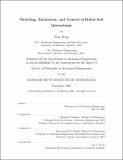| dc.contributor.advisor | J. Kenneth Salisbury and Jean-Jacques E. Slotine. | en_US |
| dc.contributor.author | Hong, Won, 1971- | en_US |
| dc.contributor.other | Massachusetts Institute of Technology. Dept. of Mechanical Engineering. | en_US |
| dc.date.accessioned | 2005-05-19T14:35:02Z | |
| dc.date.available | 2005-05-19T14:35:02Z | |
| dc.date.copyright | 2001 | en_US |
| dc.date.issued | 2001 | en_US |
| dc.identifier.uri | http://hdl.handle.net/1721.1/16785 | |
| dc.description | Thesis (Ph. D.)--Massachusetts Institute of Technology, Dept. of Mechanical Engineering, 2001. | en_US |
| dc.description | Includes bibliographical references (p. 257-267). | en_US |
| dc.description | This electronic version was submitted by the student author. The certified thesis is available in the Institute Archives and Special Collections. | en_US |
| dc.description.abstract | This thesis presents the development of hardware, theory, and experimental methods to enable a robotic manipulator arm to interact with soils and estimate soil properties from interaction forces. Unlike the majority of robotic systems interacting with soil, our objective is parameter estimation, not excavation. To this end, we design our manipulator with a flat plate for easy modeling of interactions. By using a flat plate, we take advantage of the wealth of research on the similar problem of earth pressure on retaining walls. There are a number of existing earth pressure models. These models typically provide estimates of force which are in uncertain relation to the true force. A recent technique, known as numerical limit analysis, provides upper and lower bounds on the true force. Predictions from the numerical limit analysis technique are shown to be in good agreement with other accepted models. Experimental methods for plate insertion, soil-tool interface friction estimation, and control of applied forces on the soil are presented. In addition, a novel graphical technique for inverting the soil models is developed, which is an improvement over standard nonlinear optimization. This graphical technique utilizes the uncertainties associated with each set of force measurements to obtain all possible parameters which could have produced the measured forces. | en_US |
| dc.description.abstract | (cont.) The system is tested on three cohesionless soils, two in a loose state and one in a loose and dense state. The results are compared with friction angles obtained from direct shear tests. The results highlight a number of key points. Common assumptions are made in soil modeling. Most notably, the Mohr-Coulomb failure law and perfectly plastic behavior. In the direct shear tests, a marked dependence of friction angle on the normal stress at low stresses is found. This has ramifications for any study of friction done at low stresses. In addition, gradual failures are often observed for vertical tools and tools inclined away from the direction of motion. After accounting for the change in friction angle at low stresses, the results show good agreement with the direct shear values. | en_US |
| dc.description.statementofresponsibility | by Won Hong. | en_US |
| dc.format.extent | 276 p. | en_US |
| dc.format.extent | 11101657 bytes | |
| dc.format.extent | 11101355 bytes | |
| dc.format.mimetype | application/pdf | |
| dc.format.mimetype | application/pdf | |
| dc.language.iso | eng | en_US |
| dc.publisher | Massachusetts Institute of Technology | en_US |
| dc.rights | M.I.T. theses are protected by copyright. They may be viewed from this source for any purpose, but reproduction or distribution in any format is prohibited without written permission. See provided URL for inquiries about permission. | en_US |
| dc.rights.uri | http://dspace.mit.edu/handle/1721.1/7582 | |
| dc.subject | Mechanical Engineering. | en_US |
| dc.title | Modeling, estimation, and control of robot-soil interactions | en_US |
| dc.type | Thesis | en_US |
| dc.description.degree | Ph.D. | en_US |
| dc.contributor.department | Massachusetts Institute of Technology. Department of Mechanical Engineering | |
| dc.identifier.oclc | 49836305 | en_US |
